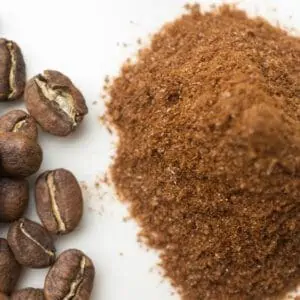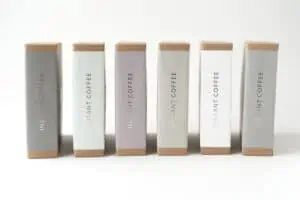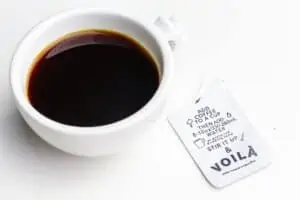It sounds easy enough. Brew the coffee, take out the water, keep the stuff that’s left, package it, and let the consumer put the water back in later. Coffee … instantly. But judging from the 24 soluble coffees we tested for our September tasting report, it isn’t quite as easy as it sounds.
It has always been difficult to judge whether the generally dreadful quality of instant coffee sold in supermarkets is owing to the effects of the dehydration process, or to the poor quality of the coffee that was dehydrated in the first place. Plus, there has always been a downward-trending chicken-and-egg thing going on. Because instant coffees have long been sold on the basis of price and convenience, rather than quality, it doubtless never made much sense to the big coffee companies to put decent coffees into their instant jars. Most supermarket instant blends probably consist almost entirely of poorer-quality Vietnamese Robustas, some of the worst coffees in the world.
Enter: Specialty Instant!
However, over the past couple of years, some entrepreneurs and open-minded specialty roasters have been exploring the possibility of offering, in instant format, coffee from single, often celebrated, growing regions, roasted to foreground the character and vivacity of the green coffee. In other words, they are aiming to bring true specialty coffee to consumers in instant format.

Roasted whole-bean coffee and soluble, or “instant,” coffee. Courtesy of Voila.
How successful is this new effort to fuse the old world of drab instant coffee with the new world of coffee distinction and variety?
Owing to the risk-taking generosity of several specialty roasting companies and three specialty-oriented soluble facilities, some quite distinguished coffee names turned up among the 24 instant coffee samples we tested this month. We tested an instant Kenya, an instant natural-processed Ethiopia, three distinguished wet-processed Ethiopias, a Costa Rica, a Peru, and three Colombias, including two very specifically identified specialty-lot Colombias. We also tested several specialty blends in instant format.
Starbucks was the first American company to attempt to break instant coffee loose from its positioning as a cheap convenience product with the commercially successful launch of its Via line of single-serve instants in 2011. We included two Starbucks Via selections in our tests this month, the “medium-roasted” (actually dark-roasted) Colombia, and the “blonde” (close to true medium-roasted) Veranda Blend.
We added to our tests by way of benchmarks three standard American supermarket instant blends and three from Asia, including Maxim, a premium offering from Korea, and two offerings from the Japanese coffee king UCC, a standard blend and a premium blend.
The Bottom Line
To return to the true specialty coffees in our test mix, is it possible to enjoy a genuinely distinguished, highly differentiated coffee in instant format? Something you can travel with, toss in a purse, take to a friend’s house who only offers French Roast, take camping? Something that will waft immediate beauty at the first dribble of hot water into a cup, even on a mountainside or at a sticky picnic table in a state park?

Instant coffee is highly portable. Courtesy of Voila.
Yes and no. Yes, the best of the new specialty instants are much, much better than the old supermarket instants. And yes, one can, dimly at times, quite clearly at others, detect the character of the green coffee behind whatever sensory static may be introduced by dehydration and rehydration. These are major achievements.
On the other hand, are the best of these specialty instants the equal of similar coffees freshly ground and brewed?
No, they’re not.
Perhaps that goal will be achieved in the future as the complex technology of brewing for instant production is even further optimized for quality, rather than efficiency and cost. But for now, based on our testing, when you drink a specialty coffee in instant format, you are losing some vivacity and detail while adding a sometimes slight, sometimes dominating wood or salt note that appears to be related to the soluble process. More on that note later.
Instants Ratings Scorecard
Here is a ratings summary for the 24 instants we tested, aggregated by category:

Consider the array of 11 specialty single-origin coffees we tested as instants recorded on the top line above. Let’s drop the lowest rating of 67, because it applies to a poor-quality commodity Colombia offered by Starbucks in its Via line. (We did test a decent Via instant, however, the 83-rated Veranda Blonde Roast Blend.) At any rate, if we drop that outlying score of 67, the average for the remaining very distinguished lineup of ten specifically identified, single-origin specialty coffees (four Ethiopias, a Kenya, a Costa Rica, a fine Peru and a Malawi, and two top Colombias) is 83. Would a similar array of such distinguished single-origin specialty coffees average 83 by our ratings system if we tested them as whole bean, freshly ground and brewed?

Swift Cup’s attractive packaging. Courtesy of Swift Cup.
Very unlikely. Probably a similar lineup of specialty coffees, well-roasted and freshly brewed from whole bean, would average, using our calibrations, somewhere around 87, with several pushing into the 90s.
Thanks to the generosity of one of the roasters, we were able to test a whole-bean version of a specialty blend against an instant version solubilized from the same beans. We rated the whole-bean version 84 and the instant version 80. Generally, we would expect a similar discrepancy of about four to five points between a freshly ground and brewed whole-bean coffee and a carefully solubilized instant version of that same coffee.
The Trade-Off
So it’s not a question of getting the same quality of experience from these instants as one would get from an equivalent freshly ground and brewed whole bean. Rather, it is a question of trade-offs: Is the dramatic gain in portability and convenience worth whatever sensory diminishment or distraction that comes with it?
The diminishment is clear enough. For example, coffees like washed Ethiopias with their citrus, flowers and cocoa tendencies simply display less citrus, flowers and cocoa in their instant incarnations, though the cocoa seems to hang around rather well. I would guess that preserving the delicate volatiles that convey flower and subtle fruit notes presents the greatest challenge during instant extraction and dehydration.
In part, however, where you land in regard to the convenience/distinction trade-off may turn on your attitude toward a sensory complex that surfaced in all of these instants, sometimes very mildly (for example, in the best specialty single-origin instants reviewed here at 84 and above), sometimes intensely and offensively so, as in the three supermarket instants, two of which are reviewed here. I have to assume that this sensory complex develops somewhere along the line during extraction and dehydration, though it also could represent staling in the finished instant powder.
At best, this note reads as wood, sometimes pleasantly fresh wood (like fir in a lumberyard or fresh-cut oak), but often a stale, salty wood. In the top-rated specialty sample, the Augie’s Ethiopia Layo Teraga Natural, solubilized by Voilà Coffee (89), the wood suggestion was fresh, crisp and clean. When the salt element was most dominant in the lower-rated samples, this note often suggested soy sauce or beef jerky.
The Ratings Map and Our Review Choices
We lead off with reviews of eight relatively high-rated specialty instant samples here, ranging in score from 83 to 89. In way of comparison, we add reviews of four very low-rated samples of the kind that have given instant coffee such a bad reputation.
Buying the New Specialty Instants
If the portability and convenience of specialty instants appeals to you, look for single-origin coffees identified by country name as well as by name of region/farm/type. In other words, the less generic and more specific the name of the green coffee, the more likely the instant version will please.
Brand Overlap
The specialty instants we tested were collaborations between roasting companies that sourced and roasted the beans, and solubilizing companies that turned those roasted beans into an instant product through brewing, dehydrating and packaging. These collaborations often generated double-branding on packages and promotional materials.

A single-serving packet of Voila Instant Coffee. Courtesy of Voila.
Sometimes the main brand name on the package is the roaster’s name, with the solubilizing company mentioned in small type. For example, the Reanimator Ethiopia Duromina, reviewed here at a solid 86, was identified on the packaging mainly by the name of the roasting company, Reanimator Coffee Roasters, with the name of the solubilizing company, Swift Cup appearing on the back of the box in much smaller print.
Often, however, it worked the other way round, with the solubilizing company in large print and the roaster’s name in small, as was the case with the Peru Rayos del Sol from solubilizer Sudden Coffee, roasted by Intelligentsia Coffee, and reviewed here at 84. In the case of the Voilà instants, the brand of the solubilizing company, Voilà, appeared on one side of the little single-serve packets, with the brand of the roaster and the name of the coffee on the other side—more or less equal billing, although Voilà remains the headliner on the boxes the packets come in.
The specialty instants we sampled were solubilized by three companies: Voilà Coffee (three samples), Swift Cup (nine samples), and Sudden Coffee (three samples). Reassuringly, all of these new companies produced successful instants, by which we mean instants that scored 84 or higher. On the downside, Swift Cup also solubilized several lower-rated (79 or lower) coffees, and Sudden Coffee solubilized one, although we suspect that that one had exceeded its shelf life at the point we tested it. The three Voilà samples tested consistently at 86 to 89.
Why the Differences?
What made some of these specialty instants pop into the mid- to high-80s, and others languish in the 70s?
The quality of the original green coffee, for starters. Blends tended to rate lower than single-origin coffees from the same companies. Presumably the single-origin green coffees were selected with more precision and care than were the more anonymous green coffees that went into the blends.
Evaluating the sensory impact of the specifics of how the coffee was brewed and solubilized is difficult, given how (understandably) reluctant solubilizing companies are to share the details of their processes. And the complexities of those processes are daunting to begin with.
In solubilizing facilities, generally, coffee is not brewed the way you and I brew it in our kitchens. It is brewed (or extracted) in part under pressure, sometimes at high temperatures, often in stages designed to progressively optimize extraction of solids at high temperatures and more flavorful elements at cooler temperatures. The basic goal at large industrialized solubilizing facilities is to produce a concentrated coffee that squeezes almost everything out of the bean. But it is possible by managing the details of the extraction to leave out a lot of the bad stuff (bitter, acrid or neutral-tasting substances) while keeping mainly substances that contribute to a balanced, aromatic cup.
Reassuringly, all of the specialty solubilizing companies that contributed samples to our tests this month prominently assert that they only extract the good stuff and leave out the bitter or acrid stuff. This includes Voilà Coffee, Swift Cup, and Sudden Coffee. It also includes Starbucks, which apparently operates one of the world’s most sophisticated solubilizing facilities in Atlanta. One wonders whether that same sophisticated plant produced both of the Starbucks Via samples reviewed here: on one hand, the clean, drinkable 83-rated Veranda Blend instant; on the other, the acrid, repulsive 67-rated Colombia.
The Shelf-Life Question
Which gets us to shelf life. As far as we could determine, none of the three new specialty solubilizing companies prints “processed on” or “best by” dates on their packaging. On its website, Swift Cup suggests that “all signs are pointing towards a VERY long” shelf life for its products, in part because studies suggest that freeze-dried foods last for years if stored in the right conditions. However, that’s food, not a subtly aromatic, fragile beverage like coffee. In an email, Kent Sheridan of Voilà Coffee estimates a shelf life of one year for his company’s instants. Sudden Coffee, on its lively, engaging website, suggests a shelf life of six months for Sudden Coffee instant tubes. Starbucks does print best-by dates on its Via packets; by inference I would guess at a one-year shelf life.
I belabor this issue because there were often dramatic differences in quality and vivacity among samples from the same solubilizing facility, differences that we could not easily explain through assumed variations in quality of the green coffees. It is a plausible (if arguable) assumption that the differences in quality we found may be in part related to length of time elapsed between solubilizing and consumption, intensified, perhaps, by variations in packaging procedures. Coffee products generally preserve aromatics better if they are packaged in a protective atmosphere, usually nitrogen gas.
Buying and Mixing Specialty Instant
At any rate, buy a top single-origin coffee name from a good specialty roaster solubilized by one of the three newer companies listed above, hope that there were no glitches at the soluble plant, and trust that the coffee was packaged well and hasn’t been sitting in its little tubes or envelopes for too long after having been solubilized.
Finding a range of the best of these specialty instants probably means buying on the Internet, though your local specialty roaster may produce and sell one.
A final hint: mix your instant with water heated to lower, green-tea-brewing temperature, not to coffee-brewing temperature—certainly not to boiling. The acrid wood and salt notes that we so frequently found objectionable in some instants were a bit less intense when we mixed samples with water heated to around 160ºF to 175ºF (70ºC to 80ºC) rather than with hotter water.
And keep your instant packets cool and dry. Processing does not make these instants indestructible.
Our Instant Protocol
Most specialty instants are dehydrated through variations on freeze-drying (concentrated coffee is frozen, pulverized, fragments are sifted, then subjected to gentle heat and a vaccum to vaporize the water remaining in the coffee). These freeze-dried coffees are packaged in tubes or envelopes that hold around 5 grams of soluble powder each. On the other hand, Starbucks Via is spray-dried (coffee concentrate is reduced to a mist which wafts down through a tower of heated air until dry). Starbucks mixes this powdered coffee with very finely ground roasted coffee in 3.3-gram tube-like envelopes.

A box of single-serve instant coffee from Swift Cup. Courtesy of Swift Cup.
Both the Starbucks and the specialty instants call for mixing the contents of these 5- to 3.3-gram single-serve packets with 8-10 fluid ounces of water. For our tests, we settled on 8.5 ounces (250 cl). When we tested instants sold in jars (all of them freeze-dried), we weighed out 5 grams, the same weight as contained in the freeze-dried specialty instant packets.
It’s All About Expectations
A final perspective on the convenience/quality trade-off. In our ratings evaluations, we were comparing instant coffees, albeit freshly mixed instant coffees, with freshly roasted whole-bean coffees brewed in close to ideal circumstances. My colleague Jason Sarley points out the obvious: We often do not experience coffee in such ideal circumstances. We squirt someone’s house blend out of an insulated coffee dispenser into a cup an hour or two after it was brewed on commercial equipment. Maybe a freeze-dried Ethiopia freshly mixed is an attractive alternative. My other colleague, Kim Westerman, often camps with her family, and for her the bottom line on these coffees was how satisfying she imagined them tasting on a foggy northern California morning after a night spent listening to the rustling of scavenging raccoons. Among the three of us, I suppose I was the outlier. I don’t camp much anymore, and I brew most of my coffee at home or at the Coffee Review lab from 92-plus coffees left over from reviews.
So I could be spoiled. Jason and Kim may be less so, and you might be inclined to weigh in with them and figure that the best of these specialty instants are a rather good expedient when your optimum private coffee infrastructure fails.










